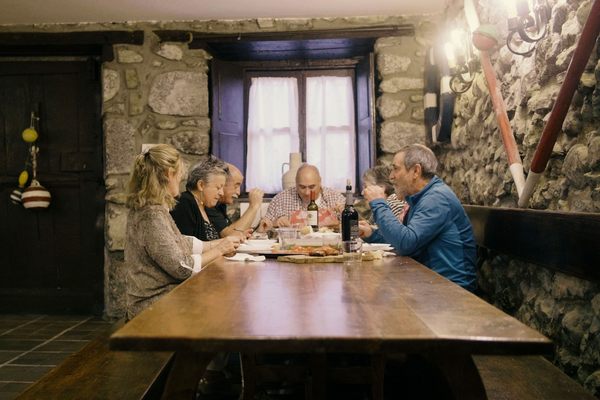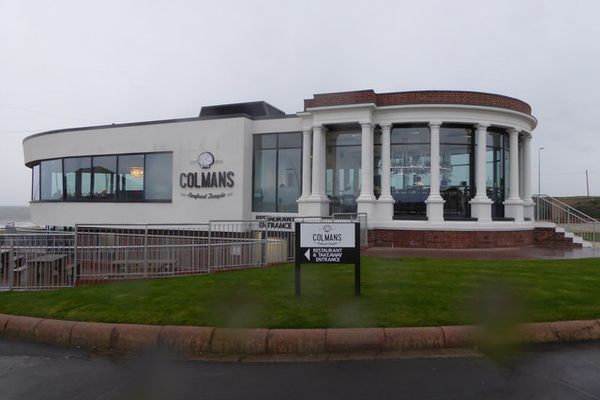A Rare Look Inside Britain’s ‘Sublime Society of Beefsteaks’
The secret dining club has extolled patriotism, masculinity, and meat since 1735.
Exclusive, men-only dining societies have long reveled in a combination of idiosyncratic eating and political partisanship. Consider the Fat Men’s Clubs of the late 19th-century United States, where members feasted on suckling pigs while networking with some of the country’s most powerful and affluent men (including former President William H. Taft), or Northern Spain’s private txokos, which blended reverence for dishes such as sukalki (a meat stew) and chuletón (rib steak) with fomenting Basque nationalism. Today, Oxford University’s Piers Gaveston Society continues its unusual dining rituals, punctuated by peculiar scandals such as that involving former British Prime Minister David Cameron and an ill-fated pig.
In Britain, these dining societies really took hold in the 1700s. An “explosion of club-ability” ushered in a rambunctious era of men-only societies steeped in eating and “an awful lot of drinking,” explains Dominic Janes, a professor of modern history at Keele University who has written several books about masculinity and Victorian Britain. Leading this culinary revelry was the Sublime Society of Beefsteaks, started in 1735 by the theatrical impresario John Rich. Not the only society devoted to beef at the time (at least another five were meeting across the United Kingdom on a regular basis), it stood out as the most popular and continues as the oldest in Britain. In his 1871 book, The Life and Death of the Sublime Society of Beefsteaks, historian Walter Arnold writes that the club grew out of casual steak-and-port dinners shared between Rich and George Lambert, a theater-scene painter. Initially drawing a diverse arts crowd, including such luminaries as William Hogarth and Samuel Johnson, its mission—as a 1754 article in The Connoisseur put it—was simple, yet profound: “Never to suffer any dish except beefsteaks.”
Every Saturday, members convened inside London’s Covent Garden Theatre (the society’s first home), their voices uniting in the club’s anthem: “A nobler flight the Goddess takes / To praise our British Beef in steaks / A joyful theme for Britons free / Happy in Beef and Liberty.” Over the years, the meeting space within the theater moved from one of the tiny painting rooms to what was described in a letter to The Connoisseur as a spacious “noble room” above the auditorium.

While the occasional vegetable side dish might’ve graced the table, beefsteak invariably claimed the spotlight. The broiling preparation was a ceremonial affair, beginning promptly at 2 p.m. with Edward Heardson, the society’s inaugural cook, overseeing every detail.
The society’s traditions extended to what historian Holger Hoock describes as “an elaborate set of pseudo-Masonic ceremonies and symbolism.” Membership, strictly capped at 24 men, was a coveted privilege, even for George IV, the Prince of Wales, who had to wait his turn. New members underwent highly theatrical initiations, pledging their oath with a kiss on the beef bone of the day, blindfolded and led by a mitre-wearing guide while other members, as Arnold describes in his account, were “all decked out in incongruous and absurd dresses.”
In their regular meetings, the members adopted a more formal demeanor, donning blue tailcoats with brass buttons and maintaining a strict hierarchy. The President of the Day, adorned with a beefeater’s hat, presided over the gatherings, the Bishop led the singing, and the Recorder managed discipline. The Boots had one of the less enviable roles, running errands, fetching wine, and enduring constant punishment, which involved being bundled into a white tablecloth and scorned by other society members. Despite the formalities, there was an underlying spirit of fun and camaraderie. “It’s very easy to go, ‘[That’s] ridiculous,’ but the rituals aren’t actually meant to be taken that seriously,” Janes says. In his book, Arnold likens the atmosphere to “a masquerade or schoolboys on holiday.”
More serious, however, was the Beefsteak Society’s role as a champion of British “Beef and Liberty,” a motto proclaimed on the buttons of each member’s coat. “The idea of beefsteaks is that they are a patriotic thing,” Janes says. Indulging in a beefsteak was an act laden with meaning, a bold emblem of patriotism set against the backdrop of England’s 18th-century wars with France. It was a direct challenge to the perceived elaborateness of French cuisine and the Catholic dietary practices of Lent. William Hogarth, artist and Beefsteak society member, encapsulated this defiance in his 1748 painting “O the Roast Beef of Old England.” Following an incident in Calais where he was arrested on suspicion of spying, Hogarth created a satirical scene of emaciated French onlookers and a corpulent monk, all fixated on a hefty beef joint en route to British diners at a nearby inn.
“It’s about the notion of prosperity, that the liberties of the British meant that middling types could eat well,” Janes says. The painting was suggesting that, unlike France, “it’s not just the aristocracy who can afford to eat meat,” Janes adds.
The Sublime Society of Beefsteaks’ disdain wasn’t limited to the French; they also sought to distinguish themselves from other Continental influences. In his paper, “From Beefsteak to Turtle: Artists’ Dinner Culture in Eighteenth-Century London,” Hoock highlights their commitment to “defending the English stage against Italian opera invasions” and other foreign artistic pursuits. He references Hogarth’s campaign for the Engravers’ Copyright Act, which prevented Italians from copying works by British engravers because they would, according to Hogarth, “depreciate every English work.”

According to Janes, the “rejection of Continental culture” demonstrated in the 1700s could illuminate contemporary attitudes in Brexit Britain, where nationalistic sentiment and xenophobia, reminiscent of the Beefsteak Society’s discourse, have resurfaced prominently in the U.K. over the past decade. Just as pro-Brexit politicians have championed economic prosperity, national sovereignty, and raised alarms over immigration, similar themes preoccupied Hogarth and his beef-eating associates. The financial growth and cultural advancements of 18th-century Britain, largely fueled by its empire, set it apart from Europe and its economic struggles. A sense of the need to protect this emerging stability and authority gave rise to political anxieties that were mirrored in many aspects of British life—including its culinary tastes—through the usual building blocks of nationalism such as liberty, patriotism, and the threat of the Other. The latter was particularly directed against perceived threats such as the “tyranny” of Continental Catholicism and absolute monarchies.
The society reserved a special kind of ridicule for the so-called Macaronis, Britons who returned from their Grand Tour with a taste for Continental delicacies like pasta and fancy wines. These men were considered the antithesis of the hearty, beef-eating British ideal that the society celebrated, and as such, they were mocked as “ridiculous men” by the Beefsteaks—or, as Janes says, “patriotic British backslappers … who celebrate[d] the fact that they have never been to the Continent.” In this cultural standoff, Janes says, “people who ate beef were self-consciously set up against the people who ate pasta.”
The society’s lampooning of the Macaronis extended beyond culinary tastes; it represented a broader rejection of what they perceived as effete European customs. Janes notes that in the 18th century, devouring large quantities of meat was a potent symbol of “British manhood.” From the Duke of Marlborough’s 1715 proclamation that “no soldier can fight unless he is properly fed on beef and beer,” to the emergence of John Bull—a stocky cartoon character frequently depicted eating beef and donning the Union Jack—in 1712, the period saw an increased valorization of the robust male form, underpinned by the belief that such strength was directly linked to a diet of beef.
The refined delicacies savored by the Macaronis and their Continental counterparts were the opposite of “manly,” according to the Beefsteak Society, a sentiment echoed in their often-sung verse: “When mighty Roast Beef was the Englishman’s Food / It ennobled our Hearts, and enriched our Blood…Then, Britons from all nice Dainties refrain / Which effeminate Italy, France, and Spain; And mighty roast beef shall command on the Main.” The celebrated radical MP John Wilkes, who served as the society’s secretary for many years, exemplified this roguish spirit. When a warrant was issued against him (for attacking the government in a satirical pamphlet), he was forced to seek refuge in Paris. He conveyed his envy for his peers in Britain in a letter, imagining the members post-feast, descending into the brothels of Covent Garden. Even the official cook, Edward Heardson, was, according to the society’s official website, a “famed bare-knuckle boxer—reputedly the champion of all England.”
Hogarth’s “Roast Beef” painting similarly works to depict the supposed contrast between British masculinity and their genteel Continental peers, according to Janes. In his article “Unnatural Appetites: Sodomitical Panic in Hogarth’s ‘The Gate of Calais,’ or, ‘O the Roast Beef of Old England,’” he notes “coded expressions of same-sex desire” among the French soldiers depicted in the painting, something that at the time was vilified and seen as a threat to conventional masculinity. Specifically, he highlights a provocatively positioned pin in the fly of a French guard’s trousers, “pointing perkily, and phallically, towards the meat,” and another figure “drooling out soup (popular slang for semen) onto the ground.”

Reflecting on the society’s emphatic display of machismo, Janes posits that “a bit of over-compensation” might have been at play within its ranks. While the Beefsteaks vehemently criticized the Macaronis as effeminate, it’s worth remembering their own penchant for what historian Richard Stephens describes as “frivolous rituals” (elaborate fancy dress, the ritualistic kissing of bones, the singing of anthems). Janes points out that contemporaries did “notice at the time that there’s something a bit unusual” about the society’s activities. He references Tobias Smollett, who satirizes Hogarth and his beef-eating associates in his novel The Adventures of Peregrine Pickle. According to Janes, Smollett appears to be questioning “all these blokes sort of hanging around and going on about beef. And, you know, not actually seeming to be spending much time with their wives.”
Today, the Beefsteaks continue to don their traditional uniform, gathering monthly (save for a summer hiatus) on Irving Street, next to Leicester Square, to uphold the society’s venerable customs. Its website cautions against any transgressions of their “ancient laws,” threatening the rule breakers with “humiliating” consequences. Yet, beyond the pomp and steak-filled pageantry, this club remains an enigma. Whispers circulate around its membership roster, hinting at the inclusion of British political figures (the disgraced former MP Brooks Newmark and Stanley Johnson, the former prime minister’s father), drawing a parallel to its tradition of welcoming MPs into the fold.
The society’s firm men-only stance has not gone without criticism. A 2018 Guardian article accused the club of sexism and inequality, while another piece pointed out that elite dining societies are “playing an increasingly important role in political life” in the U.K. and act as “magnets for fantasists, plutocrats, oddballs, and corrupt business people.” Nevertheless, the Sublime Society of Beefsteaks survives; the culture wars, gender bias, and enduring popularity of beef-eating that surrounded its inception are all still very much part of our own society.
Gastro Obscura covers the world’s most wondrous food and drink.
Sign up for our regular newsletter.


























Follow us on Twitter to get the latest on the world's hidden wonders.
Like us on Facebook to get the latest on the world's hidden wonders.
Follow us on Twitter Like us on Facebook